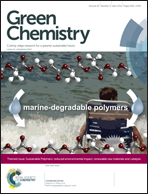Water at elevated temperatures (WET): reactant, catalyst, and solvent in the selective hydrolysis of protecting groups†
Abstract
Water at elevated temperatures (WET) can act simultaneously as reactant, solvent, and catalyst in reaction processes. WET has been successfully employed in the removal of protecting groups alleviating the need for added strong acids/bases, subsequent neutralization and waste salt elimination. The protocols for the water-mediated removal of several common protecting groups such as tert-butyl carbamates (N-Boc) from 125 to 150 °C, acetamide (N-Ac) at 275 °C and acetate esters (O-Ac) at 250 °C are reported for different model aryl compounds. In addition, high yields and selective deprotection of one protecting group in the presence of another by simply tuning the temperature is demonstrated. In order to gain further insights into reaction processes, the aqueous solubilities of several of the reactants, the kinetics and mechanisms associated with some of these reactions are also discussed.


 Please wait while we load your content...
Please wait while we load your content...